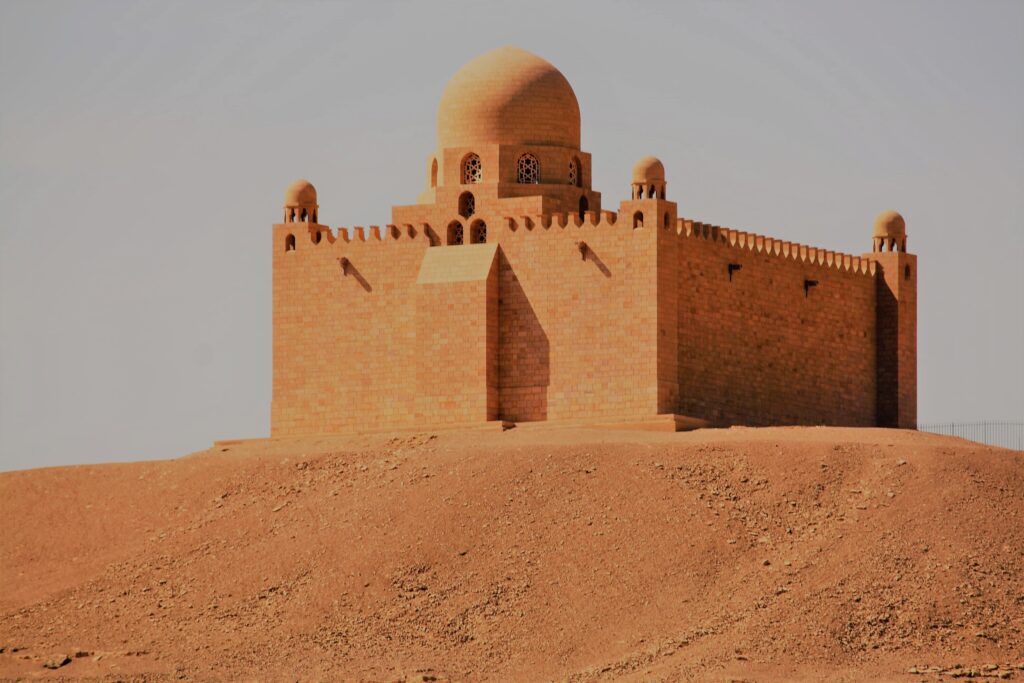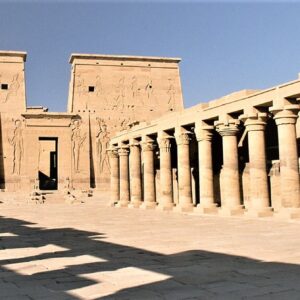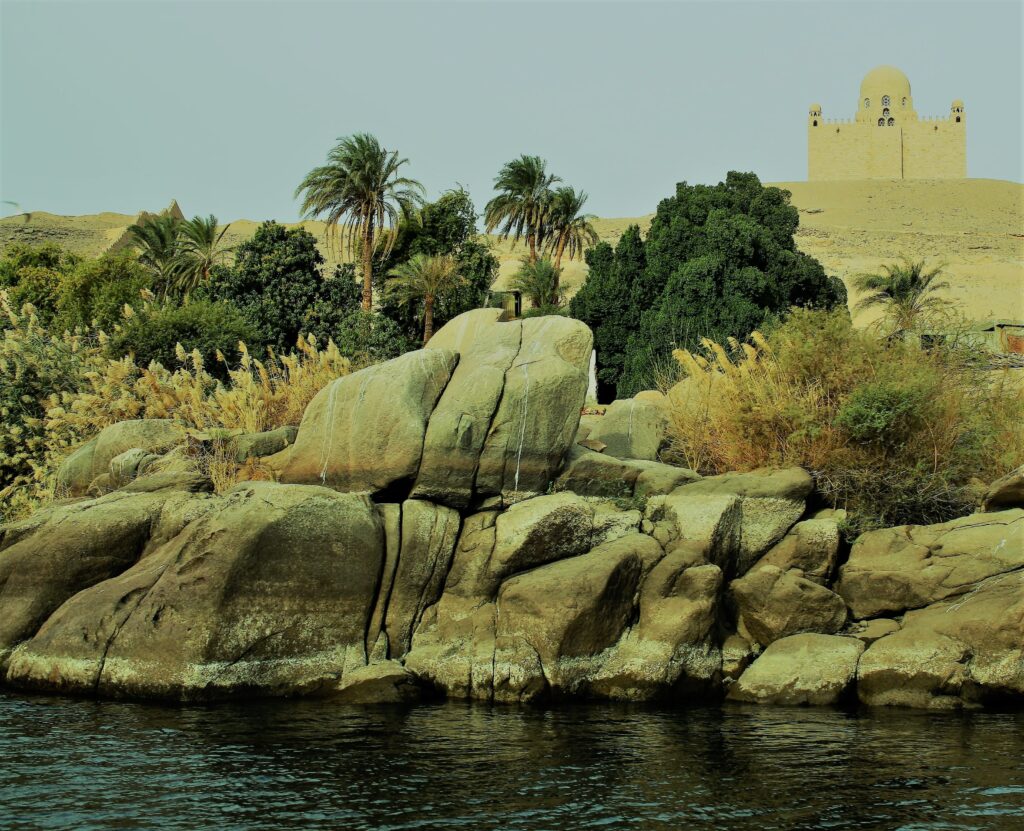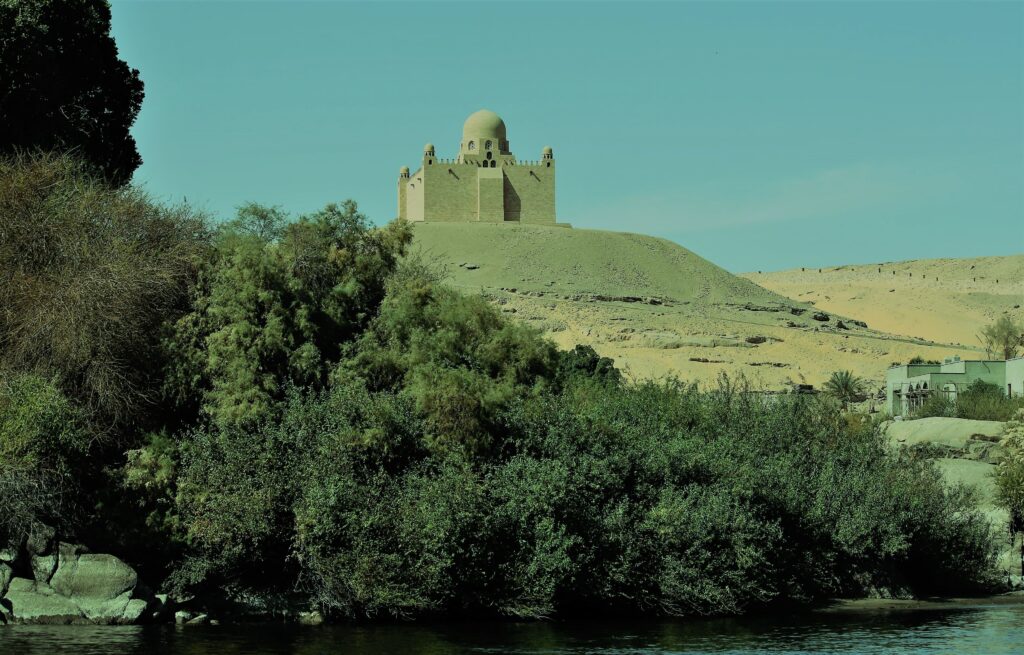
About
Aga Khan Mausoleum is the mausoleum of Aga Khan III, Sir Sultan Muhammed Shah who died in 1957. The mausoleum is located in Aswan on the Egyptian Nile, since Egypt used to be the center of power for the Fatimids, an Ismaili Shia dynasty. Construction of the mausoleum began in 1956 and ended in 1960. The Aga Khan’s wife, Begum Om Habibeh Aga Khan, commissioned the construction of the mausoleum, which initially housed tourists; however, the interior was closed to the public in 1997. Every day a red rose is placed on the tomb of the Aga Khan, a practice first started by Begum Om Habibeh Aga Khan.
Architect
The Egyptian architect Farid Shafi’e (1907-1985) designed the mausoleum, who worked as an architectural designer throughout his career; Professor and Head of the Faculty of Architecture at Cairo University; and, among others, advisors to King Abdulaziz University.[6] Other buildings designed by Farid Shafie during his career include the Royal Navy Headquarters in Cairo; the office of the Sheikh in the Al-Azhar Mosque; and a royal suite at Cairo’s Abdeen Palace. Farid Shafi’e published numerous magazine articles and books during his career, including an article on the Masjid al-Juyushi, the Fatimid building for which the mausoleum of Aga Khan III was designed in ,Some of the Shafi His other publications include Characteristics of Decorated Wood in the Abbasid and Fatimid Styles (1954); Islamic Arabic Architecture: Its Past, Present, and Future (1981); and Arab Architecture in Islamic Egypt, Volume 2: The Fatimid Era (1982).[8] Shafi’e’s previous publications indicate that he studied Fatimid architecture extensively before designing the mausoleum of Aga Khan III
Influences on style
The Mausoleum of Aga Khan III was designed to resemble the Masjid al-Juyushi, a Fatimid mosque and dedicated mausoleum built in 1085. It has a central dome and numerous smaller domes. Like Masjid al-Juyushi, the mausoleum of Aga Khan III has an inner mihrab for prayer. Despite numerous functional and aesthetic similarities, the mausoleum of Aga Khan III does not share some of the Masjid al-Juyushi’s most revered features, such as: B. the minaret, the muqarnas cornice or the inner courtyard. Based on aesthetic similarities, the architectural style of the
Aga Khan III Mausoleum may also have sought inspiration from other examples of Fatimid architecture, such as the Aswan Necropolis, a series of tombs built between the 10th and 12th centuries.
Both the Mausoleum of Aga Khan III and the Aswan Necropolis feature domes with octagonal transition zones, archways, mihrabs and building materials that blend into the surrounding desert environment (the tombs in the Aswan Necropolis were mainly built of mud brick and lined ). with lime plaster).
Exterior Design
The Aga Khan III Mausoleum is built of pink limestone, with crenellated parapets lining the outer wall, and an arched doorway on the west side of the mausoleum serves as the only entrance to the mausoleum’s interior. The east side of the mausoleum features a large central dome with arched tracery windows along the octagonal drum. There are four miniature domes at each corner of the outer wall.
You Can View Our Aswan Tours Now
Interior Design
Quranic inscriptions adorn the interior of the tomb of Aga Khan III, which is made of Carrara marble. The plan of the mausoleum shows that the tomb faces a mihrab located under the central dome on the east wall of the mausoleum.
Burial of Aga Khan III
Aga Khan III was reburied in the mausoleum on February 20, 1959, two years after his death and his first burial in Switzerland. Attendees include Aga Khan IV, Begum Om Habibeh Aga Khan and more than 2,000 other guests.] Begum Om Habibeh Aga Khan died in 2000 before being buried in her husband’s mausoleum next door
-
 Tour de un día por la Alta Presa de Asuán, Obelisco Inacabado y Templo de Philae0.00 € – 75.00 €
Tour de un día por la Alta Presa de Asuán, Obelisco Inacabado y Templo de Philae0.00 € – 75.00 € -
 Crucero por el lago Nasser: 4 días desde Asuán395.00 € – 795.00 €
Crucero por el lago Nasser: 4 días desde Asuán395.00 € – 795.00 € -
 Crucero por el Nilo de Asuán a Luxor ( 3 noches sin Abu Simbel )195.00 € – 499.00 €
Crucero por el Nilo de Asuán a Luxor ( 3 noches sin Abu Simbel )195.00 € – 499.00 €


